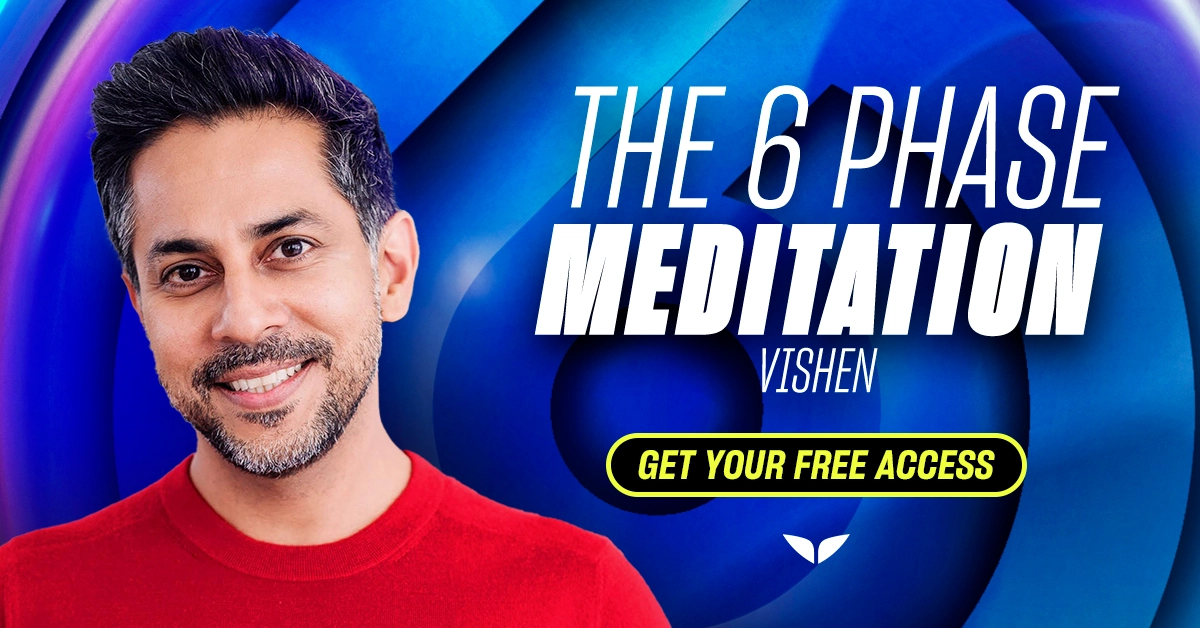Mantra meditation can profoundly impact your inner world, whether you’re seeking stress relief, sharper focus, or a deeper spiritual connection.
For Vishen, founder of Mindvalley, meditation was the turning point that reshaped every part of his life. “Meditation was the most powerful thing I’d learned in life. It was the reason why I was successful in my career,” he shares.
And in a world where mental clarity is currency, mantra meditation offers a timeless tool to come back to your center.
But what exactly are mantras, and how can this ancient practice be the modern soul’s compass?
What is a mantra?
Simply put, a mantra is a word, sound, syllable, or phrase that is repeated over and over again during meditation. It is said to have a powerful vibrational resonance.
Used across spiritual traditions—Buddhism, Hinduism, Jainism—mantras range from single syllables like “Om” to longer invocations, each carrying intention, rhythm, and meaning.
What is the purpose of a mantra?
Music (including binaural beats), focusing on the breath, or focusing on an object, are other ways of altering your consciousness, but there is something almost mystical about the sound of your own voice repeating a meditation mantra.
What is your personal mantra?
A personal mantra is a statement that motivates and inspires you to be your best self.
With a personal mantra, you affirm the way you want to live your life, as it often represents your core values. And it can help motivate you to complete your goals, both personally and professionally.
What is mantra meditation?
Meditation mantras are words or phrases you can sing, chant, hum, or repeat silently in your mind as you meditate. Unlike other meditation objects such as candles, a bowl of water, or meditation music, mantras engage both your vocal apparatus and auditory senses, creating a multi-dimensional meditation experience.
The practice works by giving your mind an object to focus on, making it easier to steady your thoughts. Ancient mantras also carry specific sound frequencies and meanings that research suggests can soothe the nervous system and facilitate greater mindfulness. This is why mantras have been used by sages and meditation practitioners around the world for over 3,000 years.
The right mantra should feel like a mirror to your intention. Choose one that aligns with your current chapter and supports the state you wish to embody.
Meditation was the most powerful thing I’d learned in life. It was the reason why I was successful in my career.
— Vishen, founder & CEO of Mindvalley and trainer of The 6 Phase Meditation program
The science behind mantra meditation
Modern neuroscience confirms what sages have known for centuries: mantra meditation doesn’t just change how you feel, it changes how your brain functions.
A 2021 study published in the International Journal of Yoga found that Om chanting led to significant decreases in cortisol levels and measurable improvements in heart rate variability, both indicating enhanced relaxation and diminished stress response.
In other words, like the meditation expert and trainer of Mindvalley’s The M Word program, Emily Fletcher explains, “When you start meditating, instead of a small part of the brain lighting up like it does in mindfulness, the whole brain lights up.”
And in that powerful state, your cognitive resilience and attentional control are elevated. Research indicates that regular mantra meditation can improve attention span, emotional regulation, and self-awareness, helping practitioners cope better with stress and challenging situations.
fMRI and EEG studies back this up. Mantra practice boosts activity in the prefrontal cortex—your executive center—supporting executive function and decision-making abilities. EEG studies have documented significant increases in alpha and theta wave activity—markers of relaxed and meditative brain states—along with decreased beta wave activity, which is typically associated with anxiety and mental arousal.

How to practice mantra meditation: a step-by-step guide
Getting started with mantra meditation is straightforward, but proper technique enhances its effectiveness. Here’s how to start, even if you’re a beginner:
Step 1: Create your sacred space
Find a quiet place where you won’t be disturbed. Sit comfortably with your spine straight but not rigid. You can sit cross-legged on the floor, in a chair, or even lying down if necessary.
Step 2: Choose your mantra
Select a mantra that resonates with you personally. This might be a traditional Sanskrit phrase, a simple English affirmation, or even a single sound like “Om.”
Step 3: Set your intention
Take a moment to clarify why you’re meditating today. Your intention might be stress relief, spiritual connection, or simply cultivating inner peace.
Step 4: Begin with breathing
Start with a few deep, conscious breaths to center yourself and transition into the meditative state.
Step 5: Start your mantra practice
Traditional mantra meditation follows a natural progression: begin by saying your mantra out loud, then gradually transition to whispering, then to mental repetition, and finally to simply listening to the mantra as it arises spontaneously in your consciousness.
Step 6: Maintain gentle focus
Don’t worry about perfect pronunciation or keeping a specific rhythm. Allow the mantra to flow naturally, returning to it gently whenever your mind wanders.
Unlock The 6 Phase Meditation program for free
Pronunciation guide for Sanskrit mantras
Proper pronunciation enhances the vibrational quality of traditional mantras. Here are phonetic guides for commonly used Sanskrit mantras:
Om (Aum): “Aum” (the “au” as in “awe,” with a nasalized “m” sound at the end)
Om Mani Padme Hum: “Aum mah-nee pud-may hoom” (the jewel in the lotus)
So Hum: “soh-hum” (I am that)
Om Namah Shivaya: “Aum nah-mah shiv-ah-ya” (I honor the divine within)
Om Shanti Shanti Shanti: “Aum shaan-tee shaan-tee shaan-tee” (peace of mind, body, and speech)
When pronouncing Sanskrit mantras, remember that “a” sounds like “uh” as in “sofa,” while “ā” is long like “ah” in “father.” The “ṃ” symbol indicates nasalization rather than a hard “m” sound.
Practical tools and techniques
Mala beads
Traditional counting beads can help maintain focus during longer sessions. A typical mala has 108 beads, allowing you to track repetitions without mental counting.
Breathing synchronization
Coordinate your mantra with your natural breath rhythm. You might repeat the mantra once per breath cycle or break longer mantras across inhalation and exhalation. Experiment with different breathwork techniques such as Box Breathing or the alternate nostril breathing method.
Session length
Begin with 5-10 minutes daily rather than attempting longer sessions immediately. Consistency matters more than duration, especially when building a new practice.
Common beginner mistakes and solutions
Understanding common pitfalls can help establish a sustainable practice:
- Expecting immediate results: Many beginners hope for instant transformation and become frustrated when dramatic changes don’t occur immediately. Instead, try approaching meditation as a gradual skill development process, focusing on regular participation rather than specific outcomes.
- Self-judgment about mind wandering: Feeling like you’re “failing” when thoughts arise is natural but counterproductive. But recognize that noticing distractions and gently returning to your mantra is the practice itself, not a mistake.
- Inconsistent practice: Irregular meditation sessions undermine habit formation and progress. As a solution, schedule a specific daily time for practice (for example, meditating in bed), even if brief, prioritizing consistency over duration.
- Overly ambitious sessions: Starting with sessions that are too long often leads to frustration and abandonment. What can work better is to begin with 3-10 minute sessions and gradually increase duration as comfort develops.
- Attachment to specific outcomes: Focusing intensely on results like bliss or stress relief can create disappointment and tension. Try a different approach and shift attention to the process itself, treating each mantra repetition as valuable regardless of perceived success.
Types of meditation that use mantras
There are many different types and meditation techniques out there. But seven of the most prominent are:
- Mindfulness meditation
- Transcendental meditation
- Guided meditation
- Vipassana meditation
- Metta meditation
- Chakra meditation
- Yoga meditation
A mantra can be incorporated into any form of meditation practice. But traditionally, the two types of meditation that make use of mantras are transcendental and Metta meditations.
Transcendental meditation is a technique in which you sit with your eyes closed and repeat a mantra to yourself twice a day for 20 minutes.
The mantra that you use in transcendental meditation is the one that you choose for yourself and that has a positive effect on you. This can be a word or a phrase, but the mantra itself is entirely up to you. This technique will help you calm down and find inner peace and relaxation.
Metta meditation, or loving-kindness meditation, is one of many meditation mantras in which good wishes are directed toward someone else.
How to practice loving-kindness mantra meditation
This powerful compassion practice uses specific mantras to develop loving acceptance. Find a comfortable position, take several deep breaths, and begin with these traditional phrases:
“May I be happy. May I be well. May I be safe. May I be peaceful and free from suffering.”
Repeat these words for several minutes, allowing the meaning and intention to resonate. After establishing this foundation of self-compassion, visualize a loved one and adapt the phrases: “May you be happy. May you be well. May you be safe. May you be peaceful and free from suffering.”
Continue expanding this practice by directing loving-kindness toward neutral people, those with whom you have difficulties, and ultimately toward all living beings. This systematic approach helps dissolve barriers between self and others while cultivating unconditional compassion.
Try it now with the renowned 6 Phase Meditation, guided by Vishen himself:
9 ancient meditation mantras
These traditional mantras have been used for centuries to facilitate deeper awareness and spiritual connection:
1. “Aum” or “Om
Considered the most sacred mantra, Om represents the original vibration of manifestation. This sound encompasses the cycle of creation, preservation, and dissolution. Many meditation masters suggest that Om helps open your chakras while simultaneously soothing the mind. The vibration literally resonates through your body when repeated, creating a tangible sense of connection to universal energy.
2. “Ham-Sah”
This Hindu mantra means “I am That” and helps cultivate the witness consciousness that observes all experiences without attachment, facilitating detachment from suffering and identification with temporary circumstances.
3. “Aham Prema”
Meaning “I am Divine Love,” this mantra helps practitioners connect with the loving essence of existence and recognize love as their fundamental nature.
4. “Om Shanti, Shanti, Shanti”
Translating to “Peace of mind, body, and speech,” this triple repetition addresses peace at all levels of existence—mental, physical, and verbal expression.
5. “Om Tat Sat”
Meaning “All that is” or “Truth, consciousness, bliss,” this mantra acknowledges the ultimate reality underlying all apparent diversity.
6. “Namo Amitabha”
This Buddhist mantra pays homage to the Buddha of boundless light, invoking infinite compassion and wisdom.
7. “I am That I Am”
Drawn from Hebrew scripture as God’s response to Moses, this mantra affirms the eternal, unchanging nature of consciousness beyond all temporary identities.
8. “I Love You; I’m Sorry; Please Forgive Me; Thank You”
Known as Ho’oponopono, this ancient Hawaiian practice combines four powerful phrases for emotional healing and reconciliation. The practice helps clear stagnant emotional energy and opens the heart to forgiveness and love.
9. “I Want Nothing. I Do Nothing. I Am Nothing.”
Suggested by spiritual leader Sri Sri Ravi Shankar, this liberating mantra addresses three key principles of meditation: freedom from desire, action, and identity. Meditating on each phrase individually can help release toxic attachments and cultivate profound inner freedom.
18 popular modern mantras in English
Contemporary mantras often focus on self-empowerment and positive psychology principles. These English phrases can be just as transformative as ancient Sanskrit formulations:
- I am enough.
- Every day, in every way, I am getting stronger.
- I am a magnet for health, wealth, and happiness.
- In me, I trust.
- I am open to the possibilities of the Universe.
- Disconnect to reconnect.
- I am in an attitude of gratitude.
- Inhale the future, exhale the past.
- I am the change.
- Everything I need is within me.
- I can and I will.
- I love myself, I believe in myself, I support myself.
- Life is short. Smile while you still have teeth.
- “I change my thoughts, I change my world.” — Norman Vincent Peale
- “Every day in every way I’m getting better and better.” — Émile Coué
- “Be the change you wish to see in the world.” — Gandhi
- “Love is the only miracle there is.” — Osho
The power of “love” and “I am” mantras
Two words consistently show up across cultures and traditions: “love” and “I am.”
“Love” as a mantra: The frequency of love is transformative. Chanting the word with heartfelt intention softens the nervous system and expands your capacity for compassion. It shifts you into coherence—physiologically and emotionally.
“I am” for manifestation: “I am,” on the other hand, is the cornerstone of identity. What follows those two words becomes a direct transmission to your subconscious. Use them wisely.
As Emily puts it, “Meditation is like plugging in your location. Manifesting is setting the destination.”
When you repeat “I am peaceful” or “I am abundant,” you’re not just stating a preference. You’re giving your inner GPS a destination—and aligning your neural pathways to match.

3 traditional Buddhist mantras
Buddhism has contributed profound mantras that emphasize compassion, wisdom, and liberation:
1. “Om Mani Padme Hum”. This Tibetan mantra, meaning “Hail the Jewel in the Lotus,” invokes the Buddha of Compassion. Each syllable is believed to purify different aspects of existence while developing empathy for oneself and all beings.
2. “Om Muni Muni Mahamuni Shakyamuniye Svaha”. The Shakyamuni Mantra honors Buddha’s wisdom and encourages the development of Buddha-nature—the inherent potential for enlightenment that exists within all beings.
3. “Om Vasudhare Svaha”. Known as the Buddhist abundance mantra, this invocation calls upon Vasundhara, the bodhisattva of earth and prosperity, representing the feminine principle of generosity and abundance.
The healing power of mantra meditation
Research confirms that chanting and mantra repetition create measurable physiological changes. Studies have shown that regular chanting can lower blood pressure, reduce stress hormones, boost immune system function, and decrease symptoms of anxiety and depression.
The vibrational quality of mantras also appears to activate the parasympathetic nervous system, promoting the body’s natural self-healing responses. Additionally, the rhythmic nature of mantra repetition can synchronize brainwave activity, promoting states of coherence between different brain regions and facilitating integration of conscious and unconscious mental processes.
Understanding Om Shanti in yoga
Om Shanti represents one of the most accessible and widely recognized mantras in modern yoga practice. While Om encompasses the sound of universal creation and dissolution, Shanti means “peace” in Sanskrit. Together, Om Shanti meaning conveys universal peace and the harmonious alignment between individual consciousness and cosmic awareness.
The mantra is often used as both a greeting and a closing in yoga classes, acknowledging the divine peace that exists within each practitioner while extending that recognition to others in the community.
Make meditation a habit
When it comes to sticking to your meditation practice, it’s crucial to let go of the myths that may be holding you back.
If you want to learn how to prime yourself for effective meditation, enroll in the free 6 Phase Meditation course with Vishen, Mindvalley founder and world-renowned meditation expert.
Thanks to this transformative practice, hundreds of Mindvalley members raised their levels of energy, achieved goals, enhanced their intuition, healed their bodies, and more.
Just like Laila Om, an astrologer and psychotherapist from Australia, who claims The 6 Phase Meditation is the most effective meditation method she has ever used. She says:
Now my life is full of joy and peace thanks to this program and meditation, and if I ever come across any challenge in my life small or big, I do Vishen’s 6 Phase Meditation, and by the time I finish the meditation, I’m already healed and with full of motivation to continue propelling towards my goal.
Ready to try it for yourself? Welcome in.








